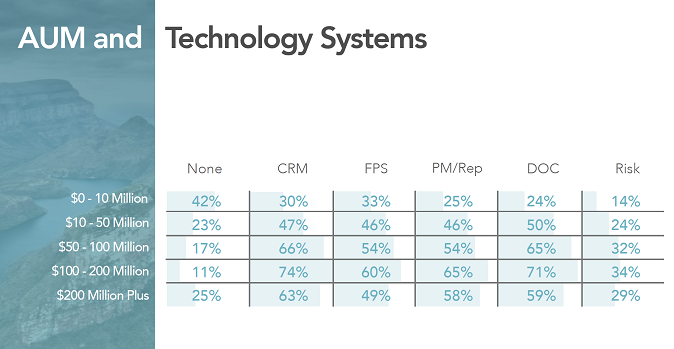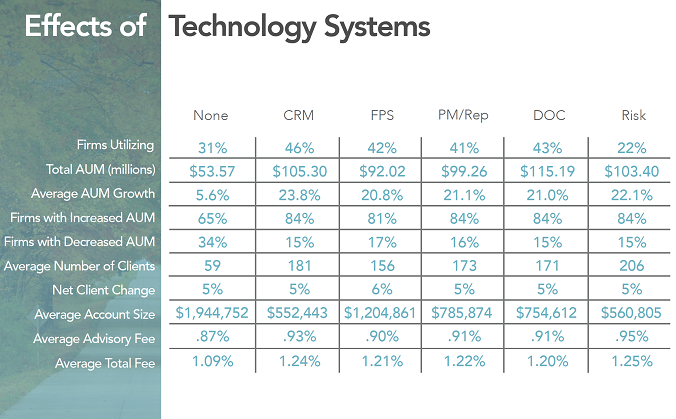The findings in this blog post come from our annual survey of over 1,500 registered investment advisor (“RIA”) firms that was conducted in the first quarter of 2018. This proprietary RIA in a Box study is paired with publicly accessible data provided by the Securities and Exchange (“SEC”). The goal of our annual study is to understand different options that comprise each firm characteristic, and to determine whether specific characteristics affect the growth, size, or operational efficiency of an RIA firm. In this blog post, we focus on the types of technology systems adopted by RIA firms of varying size as measured by regulatory assets under management (“AUM”).
Technology Adoption: Types of Systems Used
As an RIA grows to serve more clients, administrative overhead can become a burden and consumes more and more time, often at the expense of the client experience. Many new technology solutions have come to market, however, that enable RIAs to operate more efficiently and to provide a better client relationship and investment experience. For the purposes of this year’s study, we explored these five investment adviser technology categories:
- Customer Relationship Management (CRM) systems enable a firm to efficiently manage and measure its interactions with prospects and clients using email automation, call logging, and activity tracking functionality. Examples include Redtail, Salesforce, Wealthbox, & ACT!
- Financial Planning Systems (FPS) vary widely in their feature sets but share the common goal of providing the user with a modeling tool to forecast various scenarios based on a series of inputs defining a client’s current financial situation and future goals. Examples include eMoney, Money Guide Pro, and Money Tree
- Portfolio Management / Reporting (PM/Rep) systems provide varying levels asset allocation, performance display, and client billing features. Examples include Morningstar, Orion, Black Diamond, Tamarac, and Portfolio Center.
- Document Storage (DOC) systems provide cloud-based file storage to assist with file-sharing, version control, and compliance with document retention requirements. Examples include Dropbox, Box, Office 365, and Sharefile
- Portfolio Risk Measurement (Risk) systems provide portfolio risk analysis and visualizations to help ensure a client’s investment portfolio is aligned with the client’s risk tolerance. Examples include Riskalyze, Tolerisk, and Hidden Levers.
Selected Observations From Our 2018 Survey
- CRM is the most widely adopted technology system category at 46% of firms
- Risk measurement is the least widely adopted technology system category at 22% of firms
- Document storage systems become much more widely adopted as a firm grows its AUM
- 42% of firms with $10 million or less in AUM compared to 25% of firms with more than $200 million in AUM utilize no technology system
- Firms that adopt at least one technology system grow AUM at a much faster pace compared to firms that do not adopt any technology system
- Firms with a higher average account size and fewer clients are less likely to adopt technology systems
The following chart depicts the percentage of RIA firms adopting technology systems at different AUM size thresholds:

Looking at the market segments by AUM, it’s evident that the adoption of certain systems is dependent on the firm’s size. Smaller firms choose to adopt core operational solutions such as CRM and financial planning software at a higher rate. On the other hand, larger firms with increased budgets tend to spend more on specialized solutions.
The following chart shows the percentage and characteristics of firms adopting each type of technology system:

In general, firms that adopt technology have a lower average account size, have a larger volume of clients, are less likely to lose AUM, more likely to grow AUM, and more likely to grow their AUM at a higher rate.
Some solution types seem to have a greater impact than others, however it may be a bit misleading to simply compare these figures against each other. Given that a firm’s size impacts the technology adoption rate and that a single firm may be represented in one or all of these columns, these figures are better suited to understand the impact of each of these systems being adopted in isolation.
Be sure to check back soon as we next explore how the number of technology systems that an RIA firm adopts impacts its business profile and AUM growth rate.
RIA in a Box LLC is not a law firm, investment advisory firm, or CPA firm. RIA in a Box LLC does not provide legal advice or opinions to any party or client. You should always consult your relevant regulatory authorities or legal counsel if applicable.
